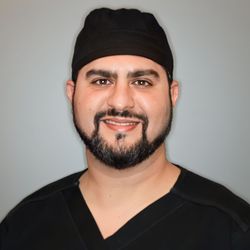Canine Exposure
Canine exposure in dentistry is a procedure that involves uncovering an impacted canine tooth and guiding it into its proper position within the dental arch. But what exactly does that mean? Let's break it down.
First, let's talk about impacted teeth. When we refer to a tooth as "impacted," it means that it hasn't fully emerged or erupted through the gums. This can occur for various reasons, but when it comes to canines specifically, they are more prone to becoming impacted than other teeth.
Canines, also known as cuspids or eye teeth, play a crucial role in your bite and overall oral function. They're located at the corners of your dental arches and have long roots designed for stability. However, due to their positioning and late eruption timing (typically around ages 11-13), they can sometimes get trapped beneath bone or adjacent teeth.
This is where canine exposure comes into play. The procedure aims to create a pathway for the impacted canine by surgically exposing part of the tooth hidden beneath soft tissue or bone. By doing so, orthodontists and oral surgeons can then attach braces or other orthodontic appliances to guide the tooth into its correct position over time.
The goal of canine exposure is not only to improve aesthetics but also to restore proper occlusion (bite) and alignment within your mouth. It helps ensure harmonious jaw movement while minimizing potential complications such as crowding, shifting of adjacent teeth, or damage to surrounding structures like roots.
So there you have it – canine exposure in dentistry serves as a necessary intervention for those with impacted canines seeking optimal oral health and function. Now that we've covered this fundamental aspect, let's explore what causes these stubborn little teeth to become impacted in the first place! Stay tuned!
What causes canine teeth to become impacted?
Canine teeth, also known as the cuspids or eye teeth, are crucial for a properly functioning bite and an aesthetically pleasing smile. However, in some cases, these teeth can become impacted – meaning they fail to erupt fully into their designated position.
There are several factors that can contribute to canine tooth impaction. One of the main causes is genetics. If a person's parents or close family members have had impacted canines, there is a higher likelihood that they will experience the same issue.
Another common cause is overcrowding in the mouth. When there isn't enough space for all the teeth to align properly, certain teeth may get blocked and prevented from coming through. The canine teeth are particularly susceptible because they tend to be larger and longer than other teeth.
In some cases, injury or trauma to the face can also lead to tooth impaction. A blow to the mouth area can disrupt the normal eruption process of canine teeth and cause them to become stuck beneath gum tissue or bone.
Abnormal growths, such as cysts or tumors near the affected tooth, can hinder its proper development and eruption.
It's essential to address impacted canine teeth promptly as it not only affects oral health but also impacts overall facial aesthetics. Seeking professional dental treatment early on is key in preventing further complications down the road.
What does the treatment of impacted canines involve?
When it comes to treating impacted canines, there are several approaches that a dentist may take. The specific treatment plan will vary depending on the severity of the impaction and the individual patient's needs.
One common method used is called orthodontic extrusion. This involves applying braces or other orthodontic appliances to gradually move the impacted canine into its proper position within the dental arch. Over time, with careful adjustments and monitoring, the tooth can be guided into place.
In some cases, surgical intervention may be necessary. This could involve exposing the impacted tooth through a small incision in the gum tissue and attaching an orthodontic bracket to it. The bracket acts as an anchor point for a chain or wire that is then connected to braces elsewhere in the mouth. By applying gentle pressure over time, this technique encourages the movement of the impacted canine into alignment.
Another option is extraction followed by replacement with a dental implant or bridge. This approach is typically reserved for cases where attempts at moving the tooth have been unsuccessful or if significant damage has occurred.
Determining which treatment method is best will depend on factors such as age, overall oral health, and personal preferences. A thorough examination by a qualified dentist or orthodontist will help guide decisions regarding treatment options for impacted canines
Conclusion
Canine exposure is a common dental procedure used to treat impacted canines. It involves the careful surgical exposure of the impacted tooth and the attachment of an orthodontic device to guide it into its proper position in the dental arch.
Impacted canines can occur due to various reasons such as overcrowding, abnormal tooth development, or genetic factors. If left untreated, they can lead to several oral health complications, including misalignment of teeth, bite problems, and even damage to surrounding teeth.
Fortunately, with advancements in dentistry and orthodontics, impacted canines can be effectively treated through canine exposure. This procedure not only helps improve oral function but also enhances aesthetics by creating a harmonious smile.
If you suspect that you or your child may have impacted canines, it is important to consult with a qualified dentist or orthodontist who specializes in this area. They will conduct a thorough examination and recommend an appropriate treatment plan tailored to your specific needs.
Remember that early detection and treatment are key when dealing with impacted canines. So don't hesitate to seek professional advice if you notice any signs or symptoms indicating potential impaction.
So stay proactive about your dental care journey – because every smile deserves attention!
Wish to learn more? Visit the Periodontal Center of Excellence Dental Implant Center at locations in The Woodlands, TX, or Conroe, TX.
Office Hours
MON - THU7:00 am - 4:00 pm
FRI7:00 am - 12:00 pm
SAT - SUNClosed
Office Hours
MON - TUEBy appointments only
WED7:00 am - 4:00 pm
THU - SUNClosed









